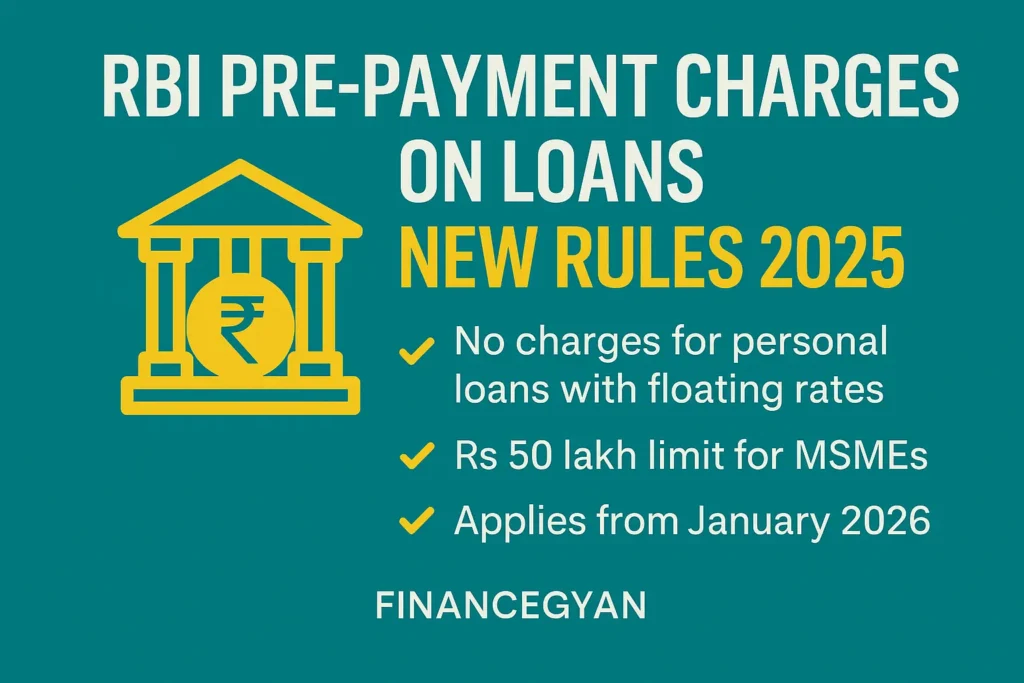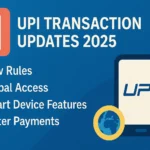
The Reserve Bank of India (RBI) has introduced a big reform in the world of banking and lending with its new RBI Pre-payment Charges Rules 2025. These rules apply to all loans sanctioned or renewed on or after January 1, 2026, and are designed to protect borrowers from hidden charges and unfair restrictions.
Pre-payment of loans means paying off your loan amount earlier than the agreed term. It could be a full payment or partial. Until now, many banks and NBFCs used to charge extra fees if you wanted to close your loan early. This made borrowers stay stuck with high interest rates even when better options were available. The RBI Pre-payment Charges Rules 2025 aim to end these unfair practices and give more freedom to the borrower.
⚡ What Are RBI Pre-payment Charges Rules 2025?
The new directions are officially called “Reserve Bank of India (Pre-payment Charges on Loans) Directions, 2025” and were released on 2nd July 2025. These RBI Pre-payment Charges Rules 2025 were created after RBI noticed that many regulated lenders were applying different policies for pre-payment, leading to confusion and complaints from customers.
The main idea is to make loan switching easier and cheaper, especially for individuals and Micro and Small Enterprises (MSEs). RBI wants to ensure customers can take advantage of lower interest rates from other lenders without being penalized. That’s why the RBI Pre-payment Charges Rules 2025 are a major positive step for borrowers.
💳 Who Do These Rules Apply To?
These RBI Pre-payment Charges Rules 2025 are applicable to all types of floating rate loans and advances, including term loans and demand loans, that are sanctioned or renewed from January 1, 2026. They cover all types of banks and lending institutions, including:
-
Commercial Banks (except Payments Banks)
-
Co-operative Banks
-
Non-Banking Financial Companies (NBFCs)
-
All India Financial Institutions
📌 What Do the New Rules Say?
Here is a simplified version of the main points of RBI Pre-payment Charges Rules 2025:
1. For Individuals (Non-Business Loans):
If you have taken a floating rate loan (like a home loan or car loan) for non-business purposes, you do not have to pay any pre-payment charges, whether you pay from your own money or take a loan from another bank. This is directly covered under the RBI Pre-payment Charges Rules 2025.
2. For Individuals and MSEs (Business Loans):
If you have taken a loan for business purposes, you don’t have to pay pre-payment charges if your lender is:
-
A Commercial Bank (except small finance, regional rural, and local area banks)
-
Tier 4 Urban Co-operative Bank
-
NBFC-UL
-
All India Financial Institution
If your loan is from a Small Finance Bank, RRB, Tier 3 Co-operative Bank, State/Central Co-operative Bank, or NBFC-ML, then no pre-payment charge will apply if your loan amount is ₹50 lakh or less, as per the RBI Pre-payment Charges Rules 2025.
3. No Lock-in Period:
There is no minimum time that you must wait before pre-paying. These rules apply no matter how soon you pay the loan.
4. Dual/Special Rate Loans:
If your loan has both fixed and floating rate parts, these rules apply only when the floating rate part is active.
5. Cash Credit/OD Accounts:
You don’t have to pay extra if you inform the bank in advance that you won’t renew the OD or cash credit facility.
6. Bank-Initiated Closure:
If the bank asks you to pre-close your loan, they cannot charge any pre-payment penalty.
7. Full Transparency:
All charges must be clearly written in the sanction letter and loan agreement. If your loan comes with a Key Facts Statement (KFS), it must mention this rule too.
8. No Hidden or Retrospective Charges:
Banks cannot charge anything extra at the time of closure that was previously waived off.
🚀 Why Is This Change Important?
This change is a game-changer for retail borrowers and small businesses. Here’s why the RBI Pre-payment Charges Rules 2025 are important:
-
You can now shift your loan to another lender with a lower interest rate without paying penalty.
-
It encourages healthy competition among banks to offer better terms.
-
It makes the lending process more transparent and borrower-friendly.
-
It will especially help MSMEs, which often suffer from high interest burdens.
🤖 RBI’s Mission: Responsible Lending
The RBI wants banks and NBFCs to follow ethical lending practices. This move shows that the RBI is listening to customer complaints and trying to make the system fair for everyone. Borrowers will now have more confidence while signing a loan agreement, thanks to the RBI Pre-payment Charges Rules 2025.
🔹 Summary Table
| Type of Borrower | Loan Purpose | Lender Type | Pre-payment Charges |
|---|---|---|---|
| Individual | Non-business | Any | No |
| Individual or MSE | Business | Bank / NBFC / AIFI (Tier 4/UL) | No |
| Individual or MSE | Business | SFB / RRB / Tier 3 / NBFC-ML | No (if ≤ ₹50 lakh) |
| Others | Any | Any | As per policy |
📝 Real-life Example
Suppose Mr. Ramesh took a home loan in March 2026 with a floating interest rate from XYZ Bank. After a year, he finds another bank offering a lower interest rate. As per the RBI Pre-payment Charges Rules 2025, he can shift his loan without paying any pre-payment charge, even if he pays using the new bank’s funds. Earlier, banks used to charge 1-2% penalty, but now this is not allowed.
📣 What Borrowers Should Do Now
-
Ask your bank if your loan is eligible under the RBI Pre-payment Charges Rules 2025.
-
Read your sanction letter and agreement carefully.
-
Use your Key Facts Statement (KFS) to compare charges.
-
Don’t hesitate to explore better loan offers from other lenders.
🌟 Final Thoughts
The RBI Pre-payment Charges Rules 2025 are a welcome move in protecting loan customers across India. These rules promote fairness, transparency, and competition in the banking sector. Whether you are an individual looking to buy a house or a small business owner, these rules can help you save thousands of rupees.
Always stay informed about your loan rights. Knowing the RBI Pre-payment Charges Rules 2025 can help you make smart financial decisions and avoid unnecessary penalties.
🤔 FAQs: RBI Pre-payment Charges Rules 2025
Q1. From when do the new rules apply?
A: These rules apply to loans sanctioned or renewed from January 1, 2026.
Q2. Are these rules for fixed rate loans too?
A: No, they apply only when your loan is under a floating rate.
Q3. Can NBFCs charge pre-payment fees?
A: No, if it’s for individuals or MSEs and the loan conditions meet the new rules.
Q4. Is there any minimum lock-in period?
A: No. You can pre-pay anytime without charges.
Q5. Does this apply to business loans?
A: Yes, especially for MSEs and individual business borrowers.
Q6. What if the loan is a mix of fixed and floating?
A: The rule applies if it is on floating rate at the time of pre-payment.
Q7. What is KFS?
A: Key Facts Statement – a document with important loan details, now must include pre-payment info.
Q8. Can my bank hide these charges?
A: No, they must clearly mention all charges in your loan documents.
Q9. Do I need to notify bank before pre-closing an OD account?
A: Yes, if you inform in advance, no pre-payment charges will be applied.
Q10. Where can I read the official RBI circular?
A: You can view it on RBI’s website here.
Also Read This
UPI Transaction Updates 2025: New Rules, Global Access & Smart Features
Best Credit Card Offers July 2025 : Cashback, Airport Lounge, Fuel & More
RBI Repo Rate Cut in 2025: How It Affects Your EMIs, Loans, and Savings

